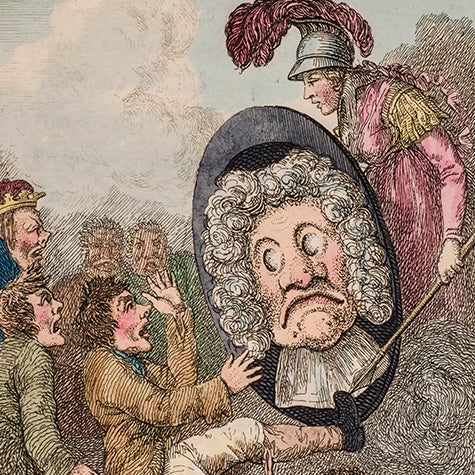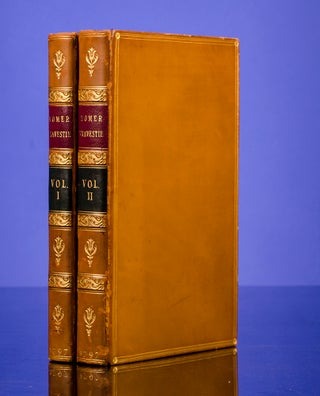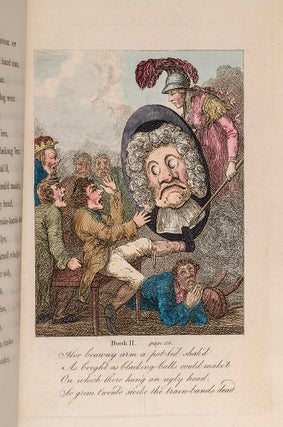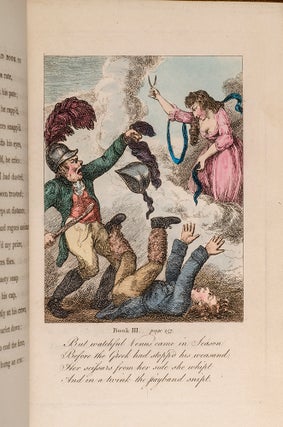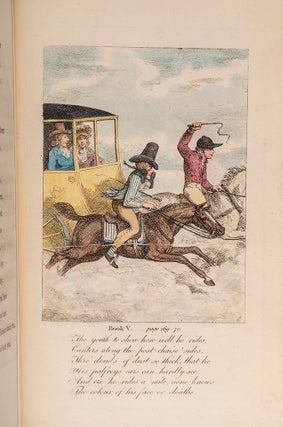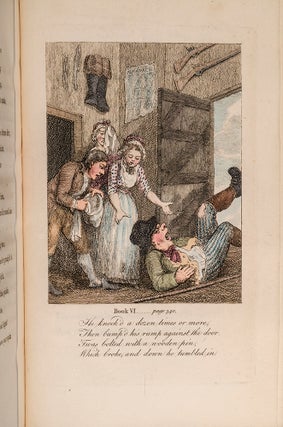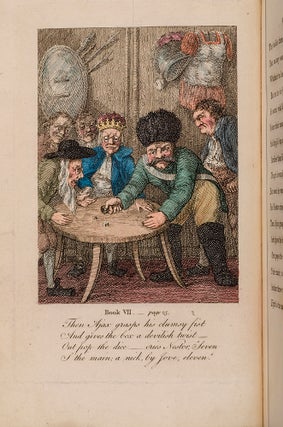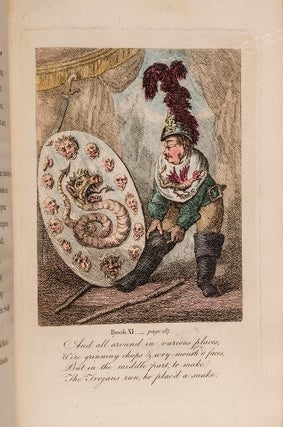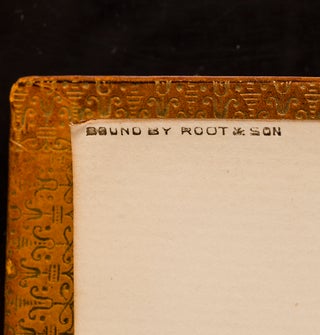Burlesque Translation of Homer, A
London: G.G. & J. Robinson, 1797. Item #04268
"A Work full of Humor Which Often Transgresses the Bounds of Decency"
With Twenty-Five Hand-Colored Etched Plates
[WOODWARD, George Moutard, illustrator]. [BRIDGES, Thomas]. [GROSE, Francis, engraver?]. A Burlesque Translation of Homer. In Two Volumes. The Fourth Edition Improved. London: G.G. & J. Robinson, 1797.
Fourth and best edition. Two octavo volumes (8 3/4 x 5 5/8 inches; 222 x 143 mm.). [6], 360; [4], 432 pp. Hand-colored etched frontispiece and twenty-four hand-colored, unsigned etched plates. In volume one, pp. 355/356 have been mis-bound after pp. 357/358. The hand-coloring is possibly contemporary or very early.
Bound ca. 1920 by Root & Son (stamp-signed on verso of front free end-paper). Full polished calf, covers triple-ruled in gilt, spines with four wide raised bands, decoratively tooled in gilt in compartments, maroon and dark blue calf labels lettered in gilt, gilt ruled board-edges, decorative gilt turn-ins, gray end-papers, top edge gilt, others uncut. A fine and large copy with the plates colored by hand.
Originally published in 1762 under the pseudonym Caustic Barebones, reprinted in 1764, and in enlarged form in 1767, 1770, and this, the fourth edition is the first edition with illustrations by Woodward.
"Best edition, with humorous plates. A work full of humour, written by Thomas Brydges, but which often transgresses the bounds of decency." (Lowndes, The Bibliographers Manual of English Literature, volume II, p. 1101).
We have never seen another colored copy. According to ABPC there has been only one other colored copy at auction over the past forty-five years (1979). We cannot locate any colored copies in OCLC.
Of George Murgatroyd Woodward (1760?–1809), caricaturist and author, the DNB notes that he, "later known as Mustard George, grew up in a Derbyshire town, living with his father and, to judge by the evidence of his later writings, received a sound education. He took early to caricature, ridiculing his neighbours in Derbyshire; a folio of these drawings dated 1781 is in the Derby Local Studies Library, among a sizable collection of his prints, drawings, and book illustrations. His caricatures having caused something of a local stir, he persuaded his father to let him seek his fortune in London.
"Apart from two caricature prints dated 1785 designed by Woodward and published by him from 28 Cary Street, Lincoln's Inn, London, it was not until 1790 that he made an impact on the London scene. Thereafter his output was copious. The British Museum catalogues list 525 examples of his work from the next twenty years, published by Holland, Fores, Ackermann, and latterly Tegg, all leading printsellers. These prints, designed by Woodward, are etched by others—Rowlandson, who was his friend and drinking companion, Isaac Cruikshank, Roberts, and Williams. Woodward's original drawings are vigorous… [and] his value lay in his humorous ideas.
"Woodward…might have rivalled Hogarth. Certainly his collaboration with Rowlandson constituted a lively, if frivolous, commentary on the social scene. Dorothy George described him as ‘original, prolific, varied, humorous and good-humoured,’ and few students of the subject would dispute her conclusion that his death was ‘a loss to caricature’ (George, English Political Caricature, 1.174)" Oxford DNB).
Some library records note the author as Thomas Bridges alone, or with Francis Grose. It was once thought by some that Grose was the author but subsequent scholars have firmly identified Thomas Bridges as the sole writer of the book. But the attribution to Grose may not have been wholly incorrect; we strongly suspect that Grose designed the etchings for the later expanded editions. He needed money and may have taken the job anonymously to protect his scholastic reputation. He certainly had the skill as a caricaturist, and the style here exhibited (particularly in the faces) is not dissimilar to examples of his work found in his Rules for Drawing Caricatures (1788). If further evidence is needed, Grose, a corpulent man who possessed no lack of self-deprecating wit concerning his girth, appears to have drawn nearly every fat man in these caricatures with his own visage. Stylistically as well as chronologically, he falls between Hogarth and Gillray. While the etchings are possibly by Grose they are definitely based on drawings by George Moutard Woodward, whose twenty-three original ink and watercolor drawings for this series were sold by Sotheby's (London) on March 6, 1978.
"Thomas Bridges (b. 1710?, d. in or after 1775), playwright and novelist, was a native of Hull, in which town his father was a physician of some repute. Thomas Bridges was a wine merchant, and a partner in the banking firm of Sell, Bridges, and Blunt, which failed in Hull in 1759. In 1762 Bridges produced, under the pseudonym of Caustic Barebones, A Travestie of Homer, in two volumes, which achieved some popularity for its spirited versification and pointed humour" (Oxford DNB). Bridges’ only novel was The Adventures of a Bank-Note, published in 1770.
Gordon, British Caricature, BC-1; Lowndes, The Bibliographers Manual of English Literature, volume II, p. 1101.
Price: $3,250.00

 I have been in the rare and antiquarian book business for over forty years; my family has been in the rare books business since 1876. Rare books are in my blood.
I have been in the rare and antiquarian book business for over forty years; my family has been in the rare books business since 1876. Rare books are in my blood.
